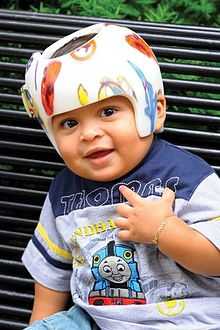Brachycephaly
| Brachycephaly | |
|---|---|
| Classification and external resources | |
| ICD-9 | 756.0 |
| DiseasesDB | 29893 |
Brachycephaly, also known as flat head syndrome, is a type of cephalic disorder. It is a normal variation in some domesticated dog and cat breeds, and can be normal or abnormal in other animal species. In humans, the disorder results from premature fusion of the coronal sutures (see craniosynostosis) or from external deformation (see plagiocephaly). The coronal suture is the fibrous joint that unites the frontal bone with the two parietal bones of the skull. The parietal bones form the top and sides of the skull. This feature can be seen in Down syndrome.
The incidence of brachycephaly has increased dramatically since the advent of sudden infant death syndrome recommendations for parents to keep their babies on their backs.[1] It is considered just a cosmetic problem.[2][3] Many pediatricians remain unaware of the issue and possible treatments. Treatments range from a simple repositioning of babies below the age of 5 months or more involved treatment with a helmet for children under the age of 18 months.[4]
There are also cases of brachycephaly associated with plagiocephaly, this deformity occurs when there is a combination of brachycephaly and plagiocephaly present. Brachycephaly with plagiocephaly is positional and has become more prevalent since the "Back to Sleep" Campaign.The Back to Sleep campaign began in 1994 as a way to educate parents, caregivers, and health care providers about ways to reduce the risk for sudden infant death syndrome (SIDS). The campaign was named for its recommendation to place healthy babies on their backs to sleep. Placing babies on their backs to sleep reduces the risk for SIDS, also known as "crib death." This campaign has been successful in promoting infant back sleeping and other risk-reduction strategies to parents, family members, child care providers, health professionals, and all other caregivers of infants, at a cost of increasing the incidence of this deformation of the head.
Brachycephaly also describes a developmentally normal type of skull with a high cephalic index, such as in snub-nosed breeds of dog such pugs and bulldogs or cats such as the Persian, Exotic and Himalayan.
Treatment

Brachycephaly can be corrected with a cranial remolding orthoses (helmet) which provide painless total contact over the prominent areas of the skull and leave voids over the flattened areas to provide a pathway for more symmetrical skull growth. Treatment generally takes 3-4 months, but varies depending on the infant's age and severity of the cranial asymmetry.
Society and culture
Flattened occiputs are considered more beautiful and a sign of luck among the elderly in some parts of China. Parents who follow this custom will rest their infants' heads on hard plates or hard pillows (filled with rice, for example) to flatten the occiputs. However, more recently, parents in China have considered rounded heads to be more beautiful and have abandoned the custom.
See also
External links
References
- ↑ John Persing et al (1 July 2003). "Prevention and Management of Positional Skull Deformities in Infants". PEDIATRICS 112 (1): 199–202.
- ↑ "Plagiocephaly and brachycephaly (flat head syndrome)". NHS. 13 February 2012.
- ↑ Matthew L. Speltz et al (15 February 2010). "Case-Control Study of Neurodevelopment in Deformational Plagiocephaly". Pediatrics. doi:10.1542/peds.2009-0052. "Although DP is considered a purely cosmetic problem by many practitioners, several studies have challenged this view."
- ↑ One Parent's Blog on Battling Brachycephaly